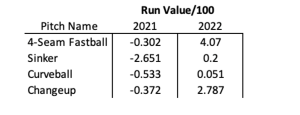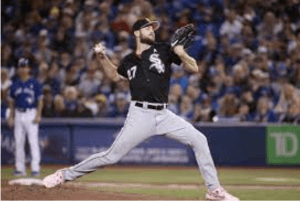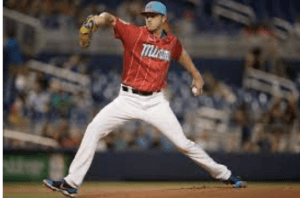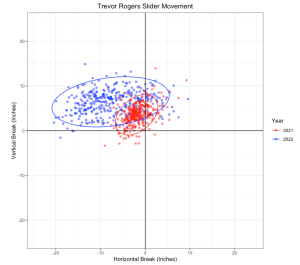Author: Michael Canmann (michaelcanmann2024@u.northwestern.edu)
Finding elite pitching is difficult. Even teams contending for the world series often have holes in their pitching staffs. Nonetheless, each of the teams in this article thought they had, at least, front-half of the rotation guys coming into the 2022 season. However, for Jose Berrios, Lucas Giolito, and Trevor Rogers, it was an extremely disappointing year. Despite each showing strong potential throughout their careers, these dealers struggled in 2022. They are all young enough to still recapture that prior success, and it’s possible that the solution to their issues could be psychological, mechanical, or simply just getting healthy.
Rather than focusing on actionable improvements for each pitcher, let’s provide more context around their individual struggles to figure out what exactly happened. Simply saying “they were bad” is not particularly helpful, so determining exactly which pitches and scenarios hurt them is the best path for painting the clearest picture.

Jose Berrios
After being traded halfway through 2021, Berrios looked like a strong new piece for Toronto’s rotation. Despite maintaining fairly similar performance in the second half of 2021, Berrios did not look like himself in 2022. He’s consistently kept an ERA in the mid-to-high 3.00’s throughout his career, but clocked in a 5.23 ERA in 2022 that finished as the worst amongst qualified starters.
The root of Berrios’s problems are two-strike counts. While he’s never been a strikeout machine, capitalizing on pitcher-friendly counts is critical for success. The table below shows the run value/100 of each of Berrios’s pitches across both years. Run value/100 uses the expected run value based on the base-out state and count to capture the exact changes in expected runs of every pitch. Pitchers want their run values to be negative as run expectancy is measured from the batting team’s perspective. Per 100 is used for interpretability because the mean change in run expectancy is usually a very small number. Berrios struggled mightily across all of his pitches in two-strike counts, as each of his pitches went from a negative to a positive run value/100.

This increase in run value has two possible explanations: Berrios either threw more balls or allowed more damage on hits. The number of balls and balls in play is important for assessing the impact of each of these outcomes, so I looked at total run value rather than average run value for each outcome with two strikes. I also initially grouped by pitch type, too, but the variance in run value across pitches made the table much-less readable and did not add much insight at all.

The table makes it fairly obvious, however, that damage accounted for most of his regression in two strike counts. While Berrios did throw more balls, he allowed over nine more runs in damage. Taking advantage when the count is in his favor again will be crucial for Berrios if he wants to recapture his success from prior years.

Lucas Giolito
The White Sox counted on Lucas Giolito to be their ace in 2022, but similar to the rest of the team, he fell short of expectations. Giolito looked more like his 2018 self with his xERA rising almost a full run from 3.27 in 2021 to 4.23 this year. His underlying metrics tell part of the story with his K% falling from 28% to 25.4%, and his BB% jumping from 7.1% to 8.7%. While these are concerning trends, the shifts aren’t quite large enough to fully explain the California native’s drop off in performance.
Analyzing Giolito’s splits, it’s clear his decline is due almost exclusively to his performance against right-handed batters. Giolito had slight reverse splits in 2021, which is not too surprising given his reliance on his changeup, allowing a .289 wOBA to lefties and .304 wOBA to righties. This year, he actually was better against lefties, allowing a .285 wOBA, but his performance against righties absolutely tanked, as he posted a dreadful wOBA of .403 against them in 2022.
Pitching against righties, his changeup usage decreased from 25.1% to 20.4%, while his fastball usage jumped from 41.7% to 46.2% in 2022. He also allowed more damage on his changeup, as his xwOBA on balls in play went from .352 to .405, and whiff rate fell from 21% to 17%. Reading the tea leaves here with his shift in pitching tendencies, coupled with the worse pitch-to-pitch performance, one could reasonably assume that Giolito lost confidence in what has been his best pitch throughout his career.
Giolito also struggled mightily when pitching from behind in the count. After falling behind 15.2% of the time in 2021, that number jumped to 18.7% in 2022, and while that alone shouldn’t be a major cause for concern, Giolito then struggled to limit the damage whenever he fell behind. In 2021, he was exceptional from behind, allowing a run value/100 of -2.609, yet this season, he allowed a run value/100 of 2.941. Again, the changeup in particular experienced the most concerning decline, with its run value/100 going from -4.412 to 3.257 in these situations.
It’s a pretty straight forward equation: if Giolito wants to return to his old form, he must regain his strength from behind in the count.

Trevor Rogers
While there’s no controversy over who the ace is in Miami, Trevor Rogers looked like a formidable complement to Sandy Alcantara after a strong campaign in 2021. Unfortunately for the Marlins, Rogers struggled to build on that success and posted a ghastly 5.47 ERA in 2022. Of note, Rogers made two major changes to his pitching style this year – one on the shape of his slider, and another with his release point.
In 2021, he threw a traditional gyro slider with little movement, but entering ‘22, Rogers added a horizontal break to switch to a sweeper-type slider. The graph below shows the spin-induced movement on Rogers’s slider from both years. To interpret this graph, think of the origin as being a ball thrown with only gyro spin, or more familiarly, like a football, and any deviation from the origin is due to back, top, or side spin being imparted on the ball.

Rogers threw his ‘21 slider in the low 80’s, which is fairly slow for a gyro slider. This low velocity was likely the motivation for the switch as sweepers tend to be more effective than gyro sliders at lower velocities. But sweepers can be a double-edged sword, as their horizontal movement causes problems for same-handed hitters, but tends to be less effective against opposite-handed hitters. Strangely, this was not the case for Rogers as his slider performed better against both types of hitters.

Roger’s slider managed contact better this year allowing a lower xwOBACON. It also maintained its whiff rate and generated improved chase rates. On and on the numbers go, and it’s evident that Roger’s slider was not the reason behind his 2022 decline.
That leaves the changes Rogers made with his release point. The table below shows his release point across three different periods. During the offseason, Rogers shifted to stand further toward the third-base side of the mound with a slight drop in release height. However, after a rough start on May 20 (The date that delineates “Early” and “Late” 2022) of this year, Rogers started standing much further toward the first-base side of the mound and dropped his release height even more.

The impact of these release point changes have been massive as illustrated by the variance in wOBA by both types of hitters across each period. Rogers’s latest release point made him more effective than ever against lefties, but left him grasping for straws when facing righties. This is because standing on the left side of the mound means his pitches are moving more to his glove-side as they approach a hitter, an advantage for right-handed batters. While these release changes from 2021 to 2022 are clearly associated with his drop in performance, it’s a stretch to extrapolate that the entirety of this relationship is causal.
Rogers’s slider and release point experienced substantial changes, but neither seem to be the culprit underlying his regression. Rather, his fastball was the main driver behind his decline, and more specifically, his fastball early in even counts. Looking at fastballs only thrown in 0-0, 1-0, 1-1, and 2-1 counts, Rogers’s run value/100 jumped from -1.404 last year to 0.78 in 2022. Fastballs in these counts accounted for about half of his fastballs thrown for both seasons. As a pitcher with a strong changeup, it is critical for Rogers to perform well early in counts, so that he can break out that deadly pitch later on. Improving his fastball results in these situations will be necessary for Rogers to have a bounceback season in 2023.

Be the first to comment on "Can the Struggling Pitchers of 2022 find it again?"